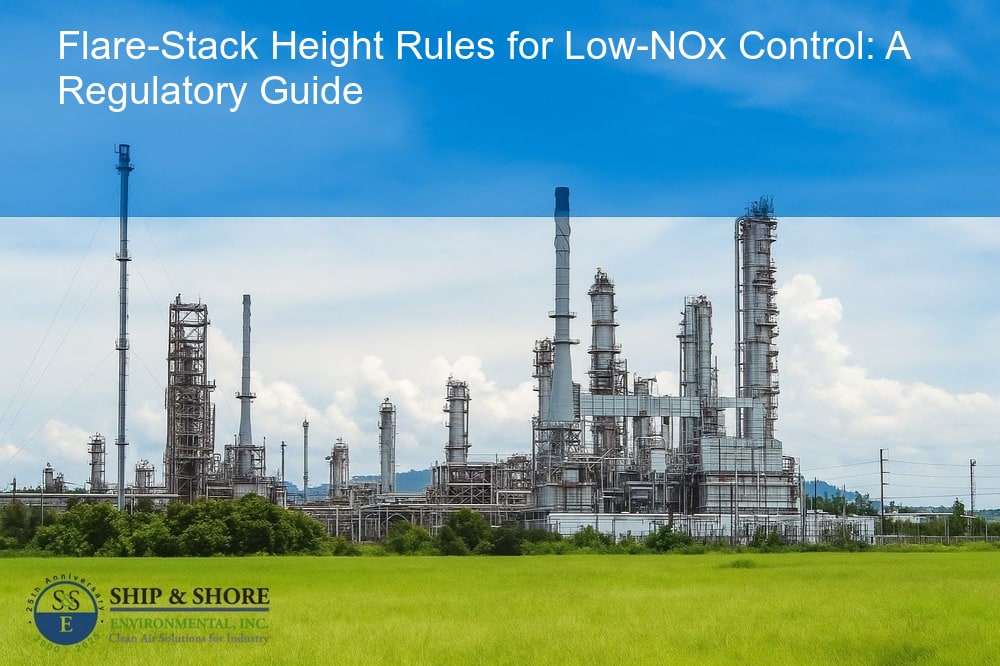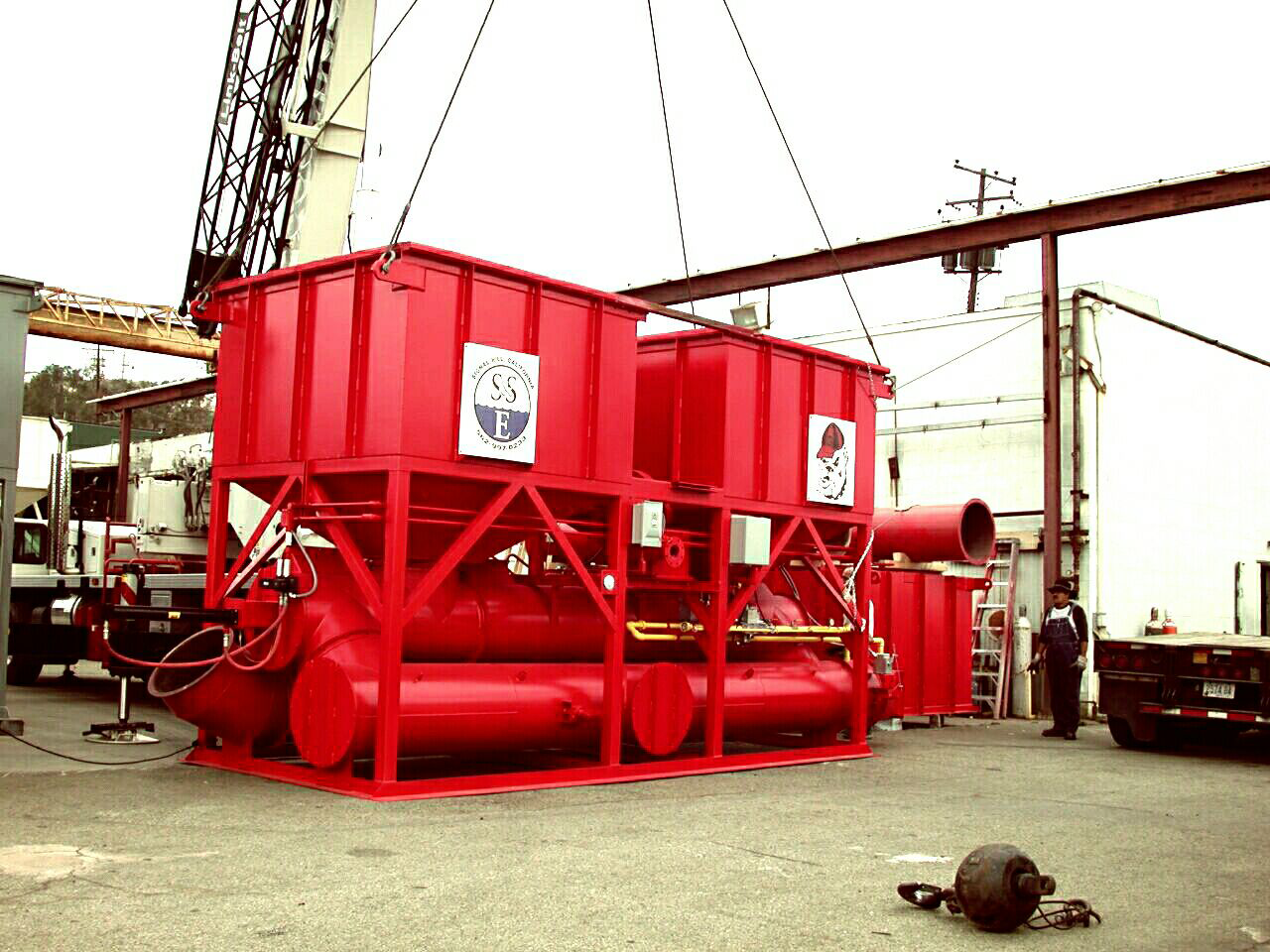
Navigating Flare-Stack Height Rules for Low-NOx Control Compliance
September 1, 2025 5:13 amThe Relevance of Flare-Stack Height Rules for Low-NOx Control
As specialists in the field of emission control, we at Ship & Shore Environmental, Inc. understand the crucial role that flare-stack height rules for low-NOx control play in maintaining air quality and ensuring regulatory compliance. The height of a flare stack is not just a matter of structural engineering; it directly influences the efficiency of combustion processes and the dispersion of pollutants, particularly nitrogen oxides (NOx). These gases, when released in significant quantities, contribute to environmental challenges such as smog formation and acid rain. Therefore, regulating flare-stack heights is essential for low-NOx control and environmental protection.
Understanding Low-NOx Control Systems
Low-NOx control systems are designed to minimize the amount of nitrogen oxides produced during the combustion process. These systems employ various techniques such as selective catalytic reduction (SCR) and low-NOx burners to reduce emissions. However, the effectiveness of these technologies can be significantly impacted by the height of the flare stack. A well-designed flare stack ensures optimal dispersion of pollutants, thereby enhancing the performance of low-NOx control systems. This interplay between flare-stack height and low-NOx technologies underscores the importance of adhering to established flare-stack height rules.
Why Regulate Flare-Stack Height?
There are several compelling reasons to regulate flare-stack height as part of our low-NOx control strategy. Firstly, taller flare stacks ensure better dispersion of emissions, which reduces ground-level concentrations of pollutants and minimizes their impact on air quality. Secondly, a properly designed flare stack can enhance the combustion efficiency, thereby reducing the production of NOx and other pollutants. Finally, compliance with flare-stack height regulations helps industries avoid potential legal and financial penalties, fostering a culture of environmental responsibility.
An Overview of Flare-Stack Height Rules
Understanding the regulations surrounding flare-stack height is crucial for industries aiming to maintain efficient low-NOx control systems. These rules stipulate the precise height requirements that flare stacks must adhere to in order to minimize the emission of harmful nitrogen oxides (NOx) into the atmosphere. Height regulations vary depending on the region and the type of industrial activity involved, but the overarching goal remains the same: to reduce environmental pollution and promote public health.
Various factors, including meteorological conditions, geographic location, and nearby population density, influence the specific requirements for flare-stack height. For instance, in areas with high population density, stricter height regulations might be imposed to ensure that NOx pollutants are dispersed higher and farther away from where people live and work.
The Interplay between Flare-Stack Height and Low-NOx Control
The relationship between flare-stack height and low-NOx control is intricately linked. By adhering to the flare-stack height rules for low-NOx control, industries can achieve a more effective dispersion of pollutants. This reduces the concentration of NOx at ground level, mitigating the environmental and health impacts.
Factors Influencing the Interplay
- Wind Speed and Direction: Both wind speed and direction affect how NOx emissions are dispersed. Taller flare stacks are better suited to handle varying wind conditions, contributing to more effective pollutant dispersion.
- Stack Design: The design of the flare stack itself also plays a role. Proper stack design, combined with appropriate height, enhances the combustion efficiency and reduces the formation of NOx.
- Operational Parameters: Temperature, flow rate, and the type of fuel used can all impact NOx emissions. Properly managed operational parameters, in conjunction with the correct stack height, are vital for effective low-NOx control.
The Impact of Non-Compliance to Flare-Stack Height Rules
Ignoring or failing to comply with flare-stack height rules can have severe consequences, both environmentally and legally. From an environmental perspective, inadequate stack height often results in higher ground-level concentrations of NOx, posing health risks to nearby communities. These increased pollutants can aggravate respiratory issues and contribute to environmental problems like smog and acid rain.
Legally, non-compliance can result in significant fines and sanctions from regulating bodies. These penalties aim to enforce adherence to environmental protections and discourage irresponsible practices. Moreover, companies that flaunt these regulations may suffer reputational damage, affecting their public image and standing within the industry.
We should also consider the operational inefficiencies that can arise from non-compliance. Improper flare-stack height could lead to inadequate combustion, causing incomplete burning of waste gases and further increasing NOx emissions. This inefficiency undermines the primary goal of low-NOx control systems and can lead to increased operational costs in the long run.
By understanding and complying with these regulations, industries can better manage their environmental impact while also ensuring efficient and effective operations.
Did you know that adjusting the height of flare stacks can significantly influence the dispersion of pollutants, thereby aiding in low-NOx emission control?
Flare-stack height regulations are crucial for minimizing atmospheric dispersion of NOx emissions from industrial sites, helping industries meet environmental standards and promoting cleaner air quality.
The Road Ahead: Innovations in Low-NOx Control
As we journey into the future of industrial emission control, the importance of adhering to flare-stack height rules for low-NOx control cannot be overstated. These regulations are not merely bureaucratic hurdles; they are fundamental to ensuring we minimize the environmental impact of our operations while maximizing efficiency. Ongoing innovations in technology promise to make low-NOx control more effective and cost-efficient, offering a promising outlook for both industry and environment.
Industry Compliance: A Unified Effort for a Cleaner Future
Compliance with flare-stack height rules embodies the industry’s collective responsibility to contribute to a cleaner, healthier environment. At Ship & Shore Environmental, Inc., we are committed to providing cutting-edge solutions that help our clients meet and exceed regulatory standards. While compliance may require investments in new technologies or modifications to existing infrastructure, the benefits far outweigh the costs. By ensuring that flare-stack heights are properly regulated, we can better control NOx emissions, thereby reducing pollution and promoting sustainable practices across various industrial sectors.
Striking a Balance: Environmental Responsibility Meets Operational Efficiency
The challenge lies in balancing environmental responsibility with the need for operational efficiency. Our focus is on designing systems that are not only compliant with flare-stack height rules for low-NOx control but also integrate seamlessly into existing industrial processes. This balance is essential for maintaining productivity while minimizing harmful emissions. Our commitment extends to continuous research and development aimed at improving the efficacy of flares in achieving low-NOx objectives. This holistic approach ensures that environmental stewardship and industrial efficiency go hand in hand.
In conclusion, the future of low-NOx control and flare-stack height regulations is not only about meeting today’s standards but also about anticipating and shaping the demands of tomorrow. By adhering to and championing these crucial regulations, we pave the way for a more sustainable industrial landscape. At Ship & Shore Environmental, Inc., we are dedicated to leading the way with innovative solutions and unwavering commitment to both our clients and our planet.
FAQ
What are the benefits of complying with regulations on flare stack heights for NOx emission control?
Adhering to regulations governing flare stack heights ensures that we effectively minimize environmental pollution from NOx emissions. Furthermore, compliance can lead to operational advantages, such as improved combustion efficiency and the potential avoidance of costly fines and penalties. As we strive to maintain a balance between environmental responsibility and industrial efficiency, observing these regulations becomes paramount.
How do flare stack height rules impact low-NOx control systems?
The height of flare stacks influences the dispersion of pollutants, including NOx, in the atmosphere. Therefore, regulations concerning stack height are closely linked with the performance of low-NOx control systems. Proper stack height aids in the efficient dispersal of emissions, which can enhance air quality and reduce the concentration of pollutants at ground level. By simultaneously investing in low-NOx technologies and complying with stack height regulations, we ensure a comprehensive approach to emission control.
What can happen if a company does not comply with flare stack height rules?
Non-compliance with flare stack height regulations may result in significant repercussions, including monetary fines and legal penalties. Moreover, neglecting to follow these rules can have detrimental environmental impacts, compromising air quality and public health. In addition, it can tarnish a company’s reputation and relationship with stakeholders. Consequently, it’s imperative to remain vigilant and ensure adherence to these critical guidelines.
How is the industry adapting to balance environmental concerns with process efficiency?
Industries are progressively adopting integrated strategies to environmental management, ensuring that their operational efficiency is not at odds with their ecological responsibilities. By implementing innovative low-NOx technologies and respecting emissions directives, including stack height stipulations, industries are creating models of sustainability that do not sacrifice productivity. Our dedication to ongoing research furthers this evolution, enabling us to develop solutions that encapsulate this delicate equilibrium.
What is the future outlook for low-NOx control technology and regulations?
Looking into the future, we anticipate ongoing advancements in low-NOx control technology that will deliver even more efficient and cost-effective solutions. Regulatory frameworks are expected to evolve in tandem with these technological breakthroughs, setting progressively stricter standards. At Ship & Shore Environmental, Inc., we are committed to fostering this growth, investing in R&D efforts, and staying ahead of the curve to assist clients in navigating these impending changes and securing a sustainable industrial future.
Categorised in: Blog

